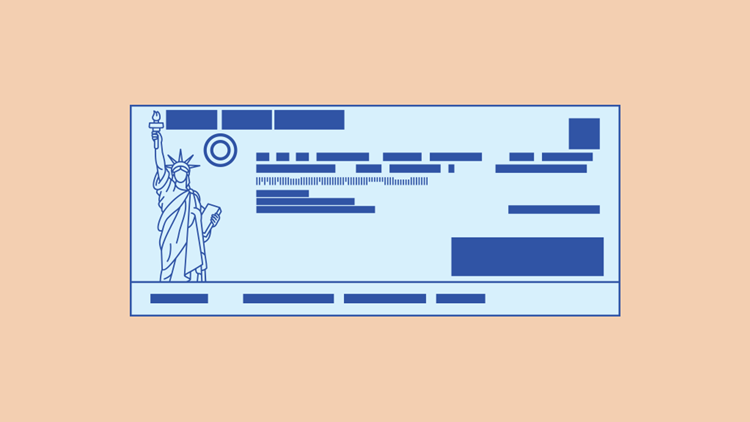by | Feb 5, 2022 | Tax Tips and News
The Internal Revenue Service is pushing out a new version of its frequently asked questions (FAQs) for the 2020 Recovery Rebate Credit. The updated information is featured in Fact Sheet 2022-08, which carries the latest information pertaining to tracing payments.

While most of the information on the Fact Sheet was updated in December 2021, Question 8 under Topic F: Finding the First and Second Economic Impact Payment Amounts to Calculate the 2020 Recovery Rebate Credit is hot off the presses, being updated February 2 of this year:
QF8. Missing Economic Impact Payment: How do I request a payment trace to track my first and second Economic Impact Payments?
A8. You should only request a payment trace to track your payment if your online account shows a first or second payment was issued to you and you have not received it. Do not request a payment trace to determine if you were eligible for a payment or to confirm the amount of payment you should have received.
How the IRS processes a claim
We’ll process your claim for a missing payment in one of two ways:
- If a trace is initiated and the IRS determines that the check wasn’t cashed, the IRS will credit your account for that payment, but the IRS cannot reissue your payment. Instead, you will need to claim the 2020 RecoveryRebate Credit on your 2020 tax return if eligible.
- Note: If you are filing your 2020 tax return before your trace is complete, do not include the payment amount on line 16 or 19 of the Recovery Rebate Credit Worksheet. If you do, you may receive a notice saying your 2020 Recovery Rebate Credit was changed, but an adjustment will be made after the trace is complete and it is determined your payment has not been cashed. You will not need to take any additional action to receive the credit. If you do not request a trace on your payment, you may receive an error when claiming the 2020 Recovery Rebate Credit on your 2020 tax return. Since the payment was issued to you, you may not be eligible for any credit.
- If the check was cashed, the Treasury Department’s Bureau of the Fiscal Service will send you a claim package that includes a copy of the cashed check. Follow the instructions. The Treasury Department’s Bureau of the Fiscal Service will review your claim and the signature on the canceled check before determining whether the payment can be reversed and your Recovery Rebate Credit adjusted.
The Fact Sheet goes on to explain that taxpayers initiating a trace need to complete Form 3911, Taxpayer Statement Regarding Refund, and gives instructions on transmitting the form to the IRS.
Alternatively, they can also call the IRS at 800-919-9535 to start a trace.
Encouraging non-filers to file
Many of the FAQs updated in December concentrate on answering the questions of non-filers who fear they might miss out on the Recovery Rebate Credit.
For example, one question asks if a taxpayer didn’t qualify for a Economic Impact Payment, would they still qualify for the Recovery Rebate Credit?
They IRS’ answers with a maybe. There are changes, the IRS stresses, that could change a taxpayer’s eligibility to the good for the credit. The first and second Economic Impact Payments were based on the taxpayer’s 2018 and 2019 income tax returns. If circumstances changed in 2020, that means eligibility for the Recovery Rebate Credit could’ve changed as well.
Here are some life changes that could open the door to qualifying for the Recovery Rebate Credit for 2020:
- Income change: Your adjusted gross income went down in 2020.
- Qualifying child: You welcomed an eligible child in 2020 who was under the age of 17 at the end of 2020.
- No longer a dependent: You were no longer eligible to be claimed as a dependent on someone else’s tax return in 2020.
- Social Security number: You received a Social Security number valid for employment before the due date of your 2020 return (including extensions).
The IRS reminds that FAQs should not be relied on for official tax law in formal proceedings such as those before the Tax Court, but are meant only to transmit changes to taxpayers quickly. More information on such reliance is available from the IRS.
Visit the IRS website, IRS.gov, for more information on the Recovery Rebate Credit.
Sources: IRS provides revised answer for 2020 Recovery Rebate Credit on tracing payments; Fact Sheet 2022-08
– Story provided by TaxingSubjects.com
by | Feb 2, 2022 | Tax Tips and News
The Internal Revenue Service has posted a new flock of frequently asked questions (FAQs), all aimed at answering taxpayer questions about the 2021 Child Tax Credit.
The new FAQs are published in Fact Sheet 2022-06.
The Child Tax Credit, expanded only for the 2021 tax year, is likely to be one of the big topics of interest to many filers this tax season.

Those taxpayers who got advance payments of the Child Tax Credit have to compare the total they got in advance payments during the tax year with the amount of the credit they can claim on their 2021 tax return.
Ideally, their advance payments could be as much as half of the total credit; they have to file to receive the remainder of the Child Tax Credit as a refund. However, if a taxpayer received more than what they qualify for, they may need to repay some—or all—of the excess paid out.
Expect a letter soon if you received the Advance Child Tax Credit
Letter 6419 has been sent out by the IRS to those who received advance Child Tax Credit payments. It provides these taxpayers with the total amount of advance payments they received during the 2021 tax year. Taxpayers who get this letter are being urged by the IRS to hang onto the document as part of their important tax documents, since they may need it to prepare their returns this season.
The new FAQs help to explain the workings of the Child Tax Credit in a number of scenarios:
Fact Sheet 2022-06 makes it clear, however, that these new FAQs are for the benefit of taxpayers and shouldn’t take the place of the rule of law in deciding tax cases.
“Accordingly, these FAQs may not address any particular taxpayer’s specific facts and circumstances, and they may be updated or modified upon further review,” the Fact Sheet explains.
“Because these FAQs have not been published in the Internal Revenue Bulletin, they will not be relied on or used by the IRS to resolve a case. Similarly, if an FAQ turns out to be an inaccurate statement of the law as applied to a particular taxpayer’s case, the law will control the taxpayer’s tax liability.”
The IRS stresses that FAQs are simply the vehicle the agency uses to get information to taxpayers quickly.
Sources: IR-2022-21; Fact Sheet 2022-06
– Story provided by TaxingSubjects.com
by | Feb 1, 2022 | Tax Tips and News
The gates have been opened just a little bit wider so more taxpayers who don’t have children can take advantage of the Earned Income Tax Credit (EITC).
The EITC is the largest refundable tax credit in the federal tax structure, aimed at low- to moderate-income taxpayers.
If it means qualifying for a larger credit, taxpayers now can actually use their income levels dating back to before the pandemic began to calculate their eligibility.
The news of a larger credit was released to help mark the 16th annual EITC Awareness Day.
“There are important changes to EITC that will help this credit reach more hard-working families this year,” said IRS Commissioner Chuck Rettig.
“We urge people potentially eligible for this valuable credit to review the guidelines; many people each year overlook this and leave money on the table. On this EITC Awareness Day, we want to make sure everyone who qualifies for the credit knows about it and has the information they need to get it.”
The Earned Income Tax Credit was passed back in 1975 as one of the U.S. government’s largest programs to fight poverty. EITC Awareness Day is used to urge people to check the EITC guidelines, to see if they qualify.
Those who don’t normally file a return are also being asked to look at whether they might qualify for the EITC and other credits, such as the Child Tax Credit or the Recovery Rebate Credit.
The expansion is a one-time offer
The expanded EITC is for the 2021 tax year only. It means more childless workers and couples are eligible for the credit, while the maximum credit available has almost tripled for these taxpayers. In addition, the credit is now available to younger workers and senior citizens for the first time.
Other changes help to widen the appeal of the EITC. For 2021, the credit is generally available to those without children who are at least 19 years old. The credit is available to single filers earning up to $21,430 for the year and $27,380 for married couples filing jointly.
For filers without any qualifying children, the maximum credit rises by $538 to $1,502. There are also special exceptions in place for filers who are 18 years old and were formerly in foster care or are homeless.
While there’s no upper age limit to claim the credit if the taxpayer has earned income, full-time students under the age of 24 do not qualify.
Previously, the credit for those with no dependents was limited to taxpayers between the ages of 25 and 64.
The new rules for 2021 also allow taxpayers to calculate the EITC using earned income figures from 2019 if that was higher than that in 2021.
Taxpayers claiming the EITC must have earned income from employment or other sources, and the option could help workers get a larger credit if they actually earned less in 2021 or got unemployment benefits instead of regular wages in 2021.
Line 27-c in the instructions for Form 1040 has more information on this.
Which employed taxpayers qualify?
Workers at risk for overlooking this credit include those taxpayers:
- Without children, including those workers who are at least 19 years old and older than 64
- Living in non-traditional families, such as a grandparent raising a grandchild
- Whose earnings declined or whose marital or parental status changed
- With limited English language skills
- Who are members of the armed forces
- Living in rural areas
- Who are Native Americans
- With disabilities or who provide care for a disabled dependent
The amount of the credit was increased for the 2021 tax year, as well as the phaseout income limits. A married couple, for example, who files jointly with three or more children has a maximum credit amount of $6,728 and can earn up to $57,414 before the credit phases out. In 2020, the same couple with the same earnings would have topped out at $6,660 in credit and phased out at $56,844.
It should be noted that Economic Impact Payments or Child Tax Credit Payments are not taxable and can’t be counted as income to claim the EITC.
Claiming the EITC
Our choice for getting the most out of the Earned Income Tax Credit is to use a trusted tax professional. A trusted tax pro can not only prepare a tax return, but can also provide helpful guidance and advice.
Tips for choosing a return preparer, including certified public accountants, enrolled agents and many others, are available on IRS.gov.
For additional information, visit EITC Central, look over Publication 596, Earned Income Credit (EIC), or visit the Tax Professionals webpage, with valuable EITC resources.
Source: IR-2022-20
– Story provided by TaxingSubjects.com
by | Jan 29, 2022 | Tax Tips and News
We’ve only had one week of filing season, and scammers are already trying to make life miserable for everyone else. While this isn’t a shocking turn for anyone who has been paying attention to the evolution of identity theft tax refund fraud, it’s a problem that everyone needs to be aware of nonetheless.
This week, the Internal Revenue Service is warning that identity thieves are posing as IRS agents in a wide range of scam phone calls. According to the agency, criminals are “posing as IRS agents in hopes of stealing taxpayer money or personal information.”
How will I know if a phone call from “the IRS” is actually a scam?
Identity thieves generally try to create a sense of urgency when they contact you. Their strategy is to put you in a state of fear or anxiety through threats or by offering deals that sound too good to be true. If these criminals set the hook, you might not realize it’s a scam until it’s too late. That’s why you and your clients must become familiar with the common types of bait in the phishing tackle box.
The IRS lists four things their agents will never do when contacting taxpayers:
- Call to demand immediate payment using a specific payment method such as a prepaid debit card, gift card, or wire transfer. Generally, the IRS will first mail a bill to any taxpayer who owes taxes. Threaten to immediately bring in local police or other law enforcement groups to have the taxpayer arrested for not paying.
- Demand that taxes be paid without giving taxpayers the opportunity to question or appeal the amount owed.
- Call unexpectedly about a tax refund.
While specifically cited concerning phishing calls, these tactics are also common in phishing emails and social media scams.
What should I do if I receive a tax-related scam phone call?
If you or a client receives one of these phone calls, the IRS says step one is to write down the number and hang up. Remember, some fraudsters use what you say during one of these calls to start building a profile that they refine for future scams—in other words, do not try to emulate that TED Talk. (Though watching it is admittedly a fun way to spend ten minutes!)
Next, the agency says to report the phone call to the Treasury Inspector General for Tax Administration (TIGTA) and the IRS. That involves contacting TIGTA through their “Report a Crime or IRS Employee Misconduct” page or calling 800.366.4484, then sending an email containing the suspicious phone number—subject: “IRS Phone Scam”—to Phishing@IRS.gov.
The IRS closes their Tax Tip with links to two important tax-related scam resources:
Also, be sure to check out the “Security Summit” page on IRS.gov.
Source: Tax Tip 2022-15
– Story provided by TaxingSubjects.com
by | Jan 27, 2022 | Tax Tips and News
The Internal Revenue Service says it has sent out all the third-round Economic Impact Payments (EIPs), but the agency is quick to add that taxpayers who missed out on the EIP still have one more chance to claim their money.
These individuals will have to file a 2021 income tax return and claim the Recovery Rebate Credit in order to collect.
Why these individuals didn’t take advantage of the third Economic Impact Payments can vary. Maybe they just waited too long to go online and register for the EIP. Or perhaps they had a child born in 2021 who came into the world too late to qualify for the credit.
By claiming the Recovery Rebate Credit on their tax return, these parents can receive up to $1,400 for their new child.
Some EIPs are still in the process of being delivered, but the IRS is done issuing any of the three Economic Impact Payments.
As of the end of 2021, the IRS had issued more than 175 million third-round EIPs, totaling over $400 billion to individuals and families across the U.S.
In January, the IRS started sending out Letter 6475, Your Third Economic Impact Payment, to those who received the third-round EIP. The letter was designed to help EIP recipients determine if they’re entitled to claim the Recovery Rebate Credit, and if so, how to claim it.
Who can still claim the Recovery Rebate Credit?
The third-round Economic Impact Payment was basically an advance payment of the Recovery Rebate Credit for the 2021 tax year, based on the taxpayer’s income and number of dependents they listed on their 2019 or 2020 income tax return.
The 2021 Recovery Rebate Credit, however, is based on income and the number of dependents listed on the filer’s 2021 income tax return.
A number of scenarios could be responsible for an individual missing out on an Economic Impact Payment. Many times, it could be as simple as circumstances changing in 2021 from what they were in 2020.
Here are a few examples of people who may be eligible to get more money by claiming the Recovery Rebate Credit on their income tax return. Be aware, however, there could be others not listed here:
- Parents of a child born in 2021 who claim the child as a dependent on their 2021 income tax return may be eligible to receive a 2021 Recovery Rebate Credit of up to $1,400 for this child.
- All eligible parents of qualifying children born or welcomed through adoption or foster care in 2021 are also encouraged to claim the child tax credit — worth up to $3,600 per child born in 2021 — on their 2021 income tax return.
- Families who added a dependent – such as a parent, a nephew or niece, or a grandchild – on their 2021 income tax return who was not listed as a dependent on their 2020 income tax return may be eligible to receive a 2021 Recovery Rebate Credit of up to $1,400 for this dependent.
- Single filers who had incomes above $80,000 in 2020 but less than this amount in 2021; married couples who filed a joint return and had incomes above $160,000 in 2020 but less than this amount in 2021; and head of household filers who had incomes above $120,000 in 2020 but less than this amount in 2021 may be eligible for a 2021 Recovery Rebate Credit of up to $1,400 per person.
- Single filers who had incomes between $75,000 and $80,000 in 2020 but had lower incomes in 2021; married couples who filed a joint return and had incomes between $150,000 and $160,000 in 2020 but had lower incomes in 2021; and head of household filers who had incomes between $112,500 and $120,000 in 2020 but had lower incomes in 2021 may be eligible for a 2021 Recovery Rebate Credit.
The Recovery Rebate Credit can also be used to receive any part of the first two Economic Impact Payments the filer may have missed. If the filer didn’t get the full amount of the EIPs, or missed a payment altogether, they would need to claim the Recovery Rebate Credit on their 2020 income tax return – or to file an amended return if it’s already been processed.
Claiming the 2021 Recovery Rebate Credit
Before actually claiming the Recovery Rebate Credit, filers need to make sure they have all the documentation necessary to file an accurate return. Filing a correct return will help to avoid delays in processing and will hold up any refund payment.
Once they’re ready to file, would-be filers need to know the total amount of their third-round EIP. This amount should include any “Plus-Up” payments they received.
The IRS sent out “Plus-Up” payments to those who received a third-round Economic Impact Payment based on their 2019 tax return and were eligible for a larger amount according to updated information on their 2020 return.
Be aware that the IRS Get My Payment application will shut down at the end of January. Instead, taxpayers are urged to use their Online Account to access their EIP information.
Letter 6475 from the IRS will also have this information, although some taxpayers may not get their letter until sometime in March.
Married taxpayers filing a joint return with their spouse should remember that each spouse will have to log into their own Online Account or look over their own letter for their part of the couple’s total payment.
For the fastest refund, e-file
The same options that speed up processing of income tax returns apply for speeding up the Recovery Rebate Credit: e-file, file an accurate return and choose direct deposit for any refund.
A trusted tax professional can help their clients with all three.
The 2021 Recovery Rebate Credit will first reduce the tax due for qualified taxpayers, with the remainder added to any refund they may have. The refund of the credit will be paid along with the tax refund, so it won’t be sent out separately.
The third round of Economic Impact Payments was authorized by the American Rescue Plan Act of 2021, signed into law in March. The IRS started sending out the EIPs on March 12, 2021, and continued through the end of the year.
Source: IR-2022-19
– Story provided by TaxingSubjects.com
by | Jan 26, 2022 | Tax Tips and News
Much attention has been given lately to the Child Tax Credit and its advance payments. But another credit is available if the taxpayer’s dependents aren’t their children.
This credit is for other dependents other than children. Unlike the Child Tax Credit, the credit for other dependents is non-refundable, meaning it can reduce or even eliminate a taxpayer’s tax bill, but can’t be refunded if part of the credit amount is left over.

What dependents qualify?
The IRS limits the maximum amount for each qualifying dependent at $500, and they must fall under one of the following categories:
- Dependents who are age 17 or older.
- Dependents who have individual taxpayer identification numbers.
- Dependent parents or other qualifying relatives supported by the taxpayer.
- Dependents living with the taxpayer who aren’t related to the taxpayer.
The credit for other dependents phases out when the taxpayer’s income is more than $200,000. For married couples filing jointly, the phaseout starts at $400,000.
Which taxpayers can claim the credit?
Taxpayers can claim the credit for other dependents if:
- They claim the person as a dependent on the taxpayer’s return.
- They cannot use the dependent to claim the child tax credit or additional child tax credit.
- The dependent is a U.S. citizen, national or resident alien.
Depending on the circumstances, a taxpayer might be able to claim the child and dependent care credit and the earned income credit along with the credit for other dependents, all on the same return.
The IRS website, IRS.gov, has helpful resources that can point a taxpayer in the right direction on claiming the credit for other dependents. These include the IRS Interactive Tax Assistant and the “Does My Child/Dependent Qualify for the Child Tax Credit or the Credit for Other Dependents?” webpage.
In addition, see Publication 501, Dependents, Standard Deduction and Filing Information.
Source: Tax Tip 2022-12
– Story provided by TaxingSubjects.com









